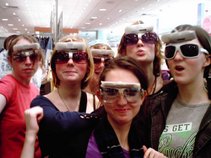
I watched Blow Out on Film4 last night because I hadn’t seen a film in a while and I thought I needed to see at least one Brian De Palma film before I died. My verdict? Stylish thriller with some areas of intrigue, but ultimately vacuous with no emotional investment.
John Travolta plays Jack Terry, a soundman currently spending his time working on cheaply made horror/porn films. On night, while out recording the wind by the river, Jack accidentally witnesses a car swerving on the road and tumbling into the creek. He has also inadvertantly recorded the sound of the whole accident on his tape. Impulsively, he jumps into the water and rescues a girl who is trapped in the back seat of the car. In doing so, he immediately gets caught up in a case of political assassination.
To tell you the truth, I’m very bad at understanding the plots of thrillers. I’m grand when it comes to Kaufman/Lynch weirdness, but as for thrillers I’m usually happy to go along with whatever is happening on the screen without too many questions. I’m not the kind of person who leaves the cinema saying “That was good – lots of holes though”. Unless the holes are the size of a grand canyon, I usually won’t spot them. I did have a few quibbles with this though, mainly why the whole thing happened in the first place? What the hell did Jack Terry see in Sally, a whingeing bimbo? And just what is up with that ending?
However, the film is interesting enough to just sit back and let wash over you. De Palma has enough visual ticks and homages up his sleeve to make Blow Out a decent watch, even if it has faults.

De Palma is a very visual director. Every scene is arranged with care and the use of lighting is especially notable. Seeing as the events in the film were all leading up to Liberty Day, the continual use of the American flag was obvious, but whites, blues and especially reds were utilised all the way through the film. In one scene, Jack and Sally are talking – his shirt is blue, hers is red and the wall behind them is white. The same colours are repeated throughout, right down to the car Jack drives. Red seems to be the most prominent of colours on De Palma’s pallet and many scenes are bathed in a dark red light, giving an air of claustrophobia and voyeurism to the whole proceedings.
There are also many allusions to other films. The very beginning of the film was very reminiscent of John Carpenter’s Halloween with the POV of an unseen murdered treading his way throughout a house, the references to Hitchcock are many (the scene in the train station, the voyeurism, boy meets girl and gets caught up into murder case) and Jack Terry handles his sound equipment with the same ardour as Travis Bickle fondles his guns in Taxi Driver. This “borrowing” leads me onto another point; is the whole of Blow Out all Heightened Reality?
Let me explain what I mean by Heightened Reality. Blow Out is full of events that would never, ever happen in real life. Warning, spoiler ahead (highlight text to see) "The ease of how the kidnap takes place, never mind that the man is kidnapping her in the middle of a busy street. The way the hospital gladly discharges Sally the night of the accident, even though she’s just been involved in a serious car accident and nearly drowned (I suppose you could argue that they were eager to get rid of her because of the political angle, but still, hospitals can’t be that immoral!)". Even down to the way John Travolta drives his car when he’s taking Sally to the motel; his hands on the wheel are moving way too much for him to be actually driving coherantly. These could all be mistakes by De Palma, but I doubt that somehow. In my opinion, they take place in a fictional reality, a sort of Movie World, within a movie. John Travolta can drive straight on the road while his hands are going ninety on the wheel because that kind of thing happens in films. Using Heightened Reality, you can do pretty much anything in your film. It doesn’t work on sci-fi or fantasy movies though, because mad shit is to be expected. Bear in mind I did come up with this theory around
Anyhow, back to the film. The acting is erratic, a sleep deprived John Travolta is good, John Lithgow plays the freaky bad guy with ease and Nancy Allen awful as the girl (her casting in this film had nothing to do with the fact that she was married to the director, nothing at all!). The script had no notable passages, not one line of dialogue or conversation sticks out in my head as memorable. The use of music was good, but that’s to be expected in a film all about sound. Finally, my biggest problem with this film was that I just didn’t care about the characters. John Travolta was likeable enough, but in the end I couldn’t quite bring myself to care whether he saved her or not. Indeed, Nancy Allen’s character was so limp I kinda wished she’d get her come-uppance.
I did enjoy the ending though – a darkly comic, twisted ending that settled things up quite nicely and brought the film to a complete circle. Quite humorous, but you think – why did I bother?



No comments:
Post a Comment